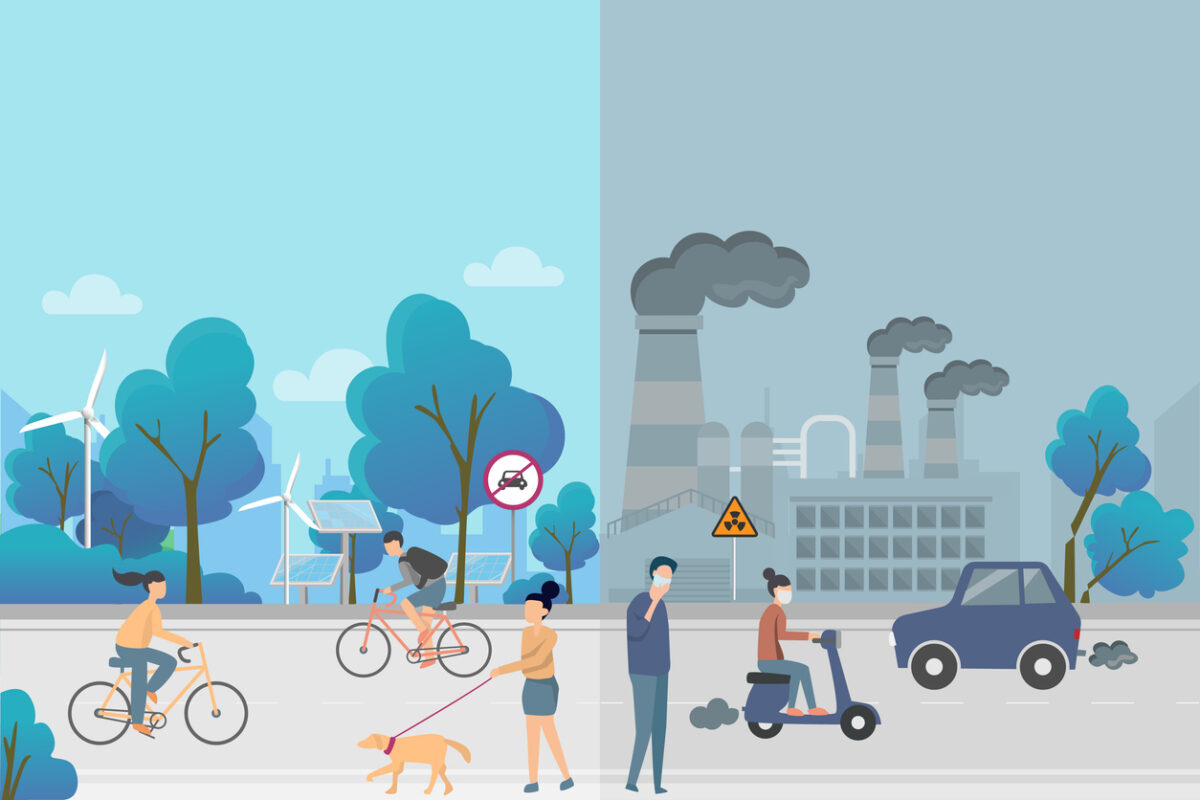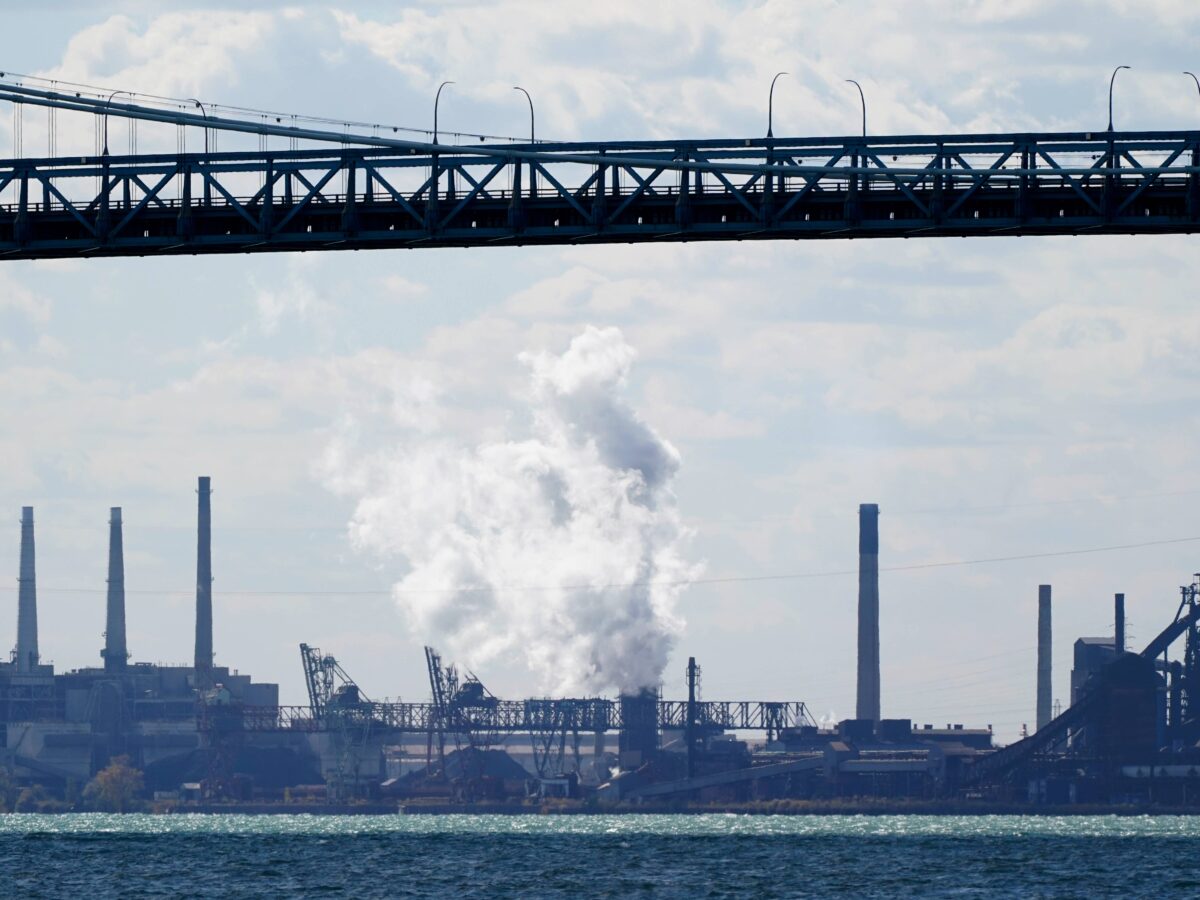Overview:
-The air quality index, ranging from zero to 500, helps communities understand pollution levels, with scores below 50 indicating safe conditions.
-Major air pollutants include ozone, particulate matter, carbon monoxide, nitrogen oxides, sulfur dioxide, and lead.
-Vulnerable groups, such as people with asthma, older adults, outdoor workers, and children, are particularly at risk from these pollutants.
Table of Contents
- Get to know the air quality index
- Air pollutants and their impacts
- Ozone
- Particulate matter
- Carbon monoxide
- Nitrogen oxides
- Sulfur dioxide
- Lead
- Take action
Poor air quality is a frequent reality for residents of Detroit. The city received a “F” for air quality in the American Lung Association’s annual State of the Air Report in April, experiencing a weighted average of nearly nine days of unhealthy air each year for particulate pollution between 2021 and 2023.
Planet Detroit spoke with a public health expert and compiled information from the Centers for Disease Control and Prevention, the Environmental Protection Agency, and the American Lung Association to make sense of the most common air pollutants and how to protect yourself from their health impacts.
Click here to read Planet Detroit’s guide specific to wildfire smoke.
Get to know the air quality index
The air quality index is a rating system that shows the severity of pollution in the air on a scale from zero to 500, a calculation made by the EPA.
The rating measures five major pollutants: ground-level ozone, particulate matter, carbon monoxide, nitrogen dioxide, and sulfur dioxide. Ground-level ozone and particulate matter are the most widespread and pose the greatest risk to health, according to the lung association.
“Measurements of the five major pollutants are calculated into the zero to 500 scale to give you one number that reflects how healthy the air is to breathe that day,” the association’s website said.
An AQI value under 50 is considered good air quality, meaning that it’s safe for anyone to spend time outdoors without risking their health. As the AQI number increases and the corresponding color code deepens, so do the risks.
🟢 Green: Good
Zero to 50 AQI – No advisory.
🟡 Yellow: Moderate
51 to 100 – Sensitive individuals should consider limiting prolonged outdoor activity.
🟠 Orange: Unhealthy for sensitive groups
101 to 150 – Children, active adults, and people with respiratory disease, such as asthma, should limit prolonged outdoor exertion.
🔴 Red: Unhealthy
151 to 200 – Children, active adults, and people with respiratory disease, such as asthma, should avoid outdoor exertion; everyone else should limit prolonged outdoor exertion.
🟣 Purple: Very Unhealthy
201 to 300 – Children, active adults, and people with respiratory disease, such as asthma, should avoid outdoor exertion; everyone else should limit outdoor exertion.
🟤 Maroon: Hazardous
301 to 500 – Everyone should avoid all physical activity outdoors.
People who are considered sensitive include children under 18, adults over 65, people with chronic heart or lung disease, and people who are pregnant or have diabetes, according to the lung association. Adults engaging in prolonged outdoor activities, such as outdoor workers and frequent exercisers, face a potentially higher risk due to extended exposure.
Dr. Natalie Sampson, an associate professor of public health at the University of Michigan-Dearborn, said the people who are most vulnerable to air pollution are already overburdened by compounding environmental issues.
“Why are we not setting safety standards based on those who are most vulnerable?” Sampson said. “Instead, we go with the average, and that’s not necessarily helpful for people’s health.”
According to the lung association report, in the U.S., people of color are more than twice as likely than white individuals to live in a community with a failing grade on all three pollution measures. Hispanic individuals are almost three times as likely as white individuals to live in such communities.
For specific health symptoms, residents should consult health care professionals like those at Community Health and Social Services Center, CHASS, or other local clinics, Sampson said. Vulnerable groups like children, pregnant people, older adults, and those with chronic health conditions, should be especially cautious, Sampson said.
Read more in Planet Detroit’s full guide to using the air quality index.
Air pollutants and their impacts
The six criteria air pollutants are ozone, particulate matter, carbon monoxide, nitrogen oxides, sulfur dioxide, and lead, according to the CDC. The EPA’s AQI accounts for the pollutants – except lead – that are regulated by the Clean Air Act.
Everyone can be impacted by these pollutants, but some people are affected more than others. Here’s how the CDC breaks down each pollutant and its impacts, and what to do when levels are high.
Ozone
Ozone is a natural and human-made gas that occurs in the Earth’s upper atmosphere, according to the Environmental Protection Agency. What we breathe – ground-level ozone – is formed by chemical reactions between volatile organic compounds, or VOCs, and nitrogen oxides, or NOx. Ozone contributes to smog or haze. Ppower plants, industrial furnaces and boilers, and vehicles are significant source, the EPA states.
Who is impacted?
- Ozone’s effects are felt more by people with asthma or other lung diseases, older adults, people who exercise or work hard outside, and babies and children.
Health impacts
- Coughing and pain when taking a deep breath.
- Lung and throat irritation.
- Wheezing and trouble breathing during exercise or outdoor activities.
When levels are high
- The CDC recommends spending more time indoors or doing easier outdoor activities, like walking instead of running, and planning outdoor activities when ozone levels are lower, usually in the morning and evening.
Particulate matter
Particulate matter is composed of tiny particles of dust, dirt, soot, smoke, or drops of liquid in the air. The particles are smaller than a single strand of hair, according to the EPA, and some particles, like smoke, are large enough to see.
Who it impacts
- Anyone can be impacted by particle pollution, especially children and older adults, and people with lung or heart disease, or diabetes.
Health impacts
- Smaller particles, called PM 2.5, can be inhaled deep into the lungs or enter the bloodstream.
- Larger particles, called PM10, irritate the eyes, nose, and throat. Dust from roads, farms, dry riverbeds, construction sites, and mines are types of PM10.
- Particle pollution is linked to trouble breathing, lung cancer, heart attacks and other forms of heart disease, and problems with babies at birth, like low birth weight.
When levels are high
- Spend more time indoors, choose easier outdoor activities, and avoid busy roads and highways where particulate matter is typically generated by emissions from cars and trucks, the CDC advises.
Carbon monoxide
Carbon monoxide is a colorless, nonirritating, odorless, tasteless gas found indoors and outdoors. It’s made when carbon fuel is not burned completely, and is produced from both human-made and natural sources. The most important human-made source is from vehicle exhaust. Industry uses carbon monoxide to manufacture compounds. It stays in the air for about two months, according to the CDC.
Who it impacts
- People who have heart or lung disease are more vulnerable to the toxic effects of carbon monoxide.
- Breathing high levels of carbon monoxide during pregnancy can cause miscarriage, and breathing lower levels can lead to delayed mental development of the child.
Health impacts
- Exposure to high levels can be life-threatening.
- Headache, nausea, vomiting, dizziness, blurred vision, confusion, chest pain, and seizures and coma have been reported in people inhaling carbon monoxide.
Reduce the risk of exposure
Make sure appliances that burn natural gasoline, kerosene, or other fuels are properly installed and vented.
- Have appliances routinely maintained.
- Always follow the manufacturer’s recommendations on installing and using these devices.
- Do not use portable propane heaters in enclosed indoor settings such as campers and tents.
- Do not let your car run idle for a long period of time in your garage.
- Carbon monoxide is a component of tobacco smoke. Avoid smoking in enclosed spaces like inside the home or car in order to limit exposure to children and other family members.
- Install carbon monoxide and smoke detectors in your home.
MORE REPORTING FROM PLANET DETROIT
State regulator asks EPA to redesignate Wayne County’s compliance with sulfur dioxide standards
The EPA will review the request and decide whether it meets Clean Air Act requirements, and the federal agency has 18 months to approve or deny the request
EPA offers Clean Air Act exemptions from Trump, and one of metro Detroit’s top polluters applies
A new EPA policy under the Trump administration could let over 500 facilities nationwide sidestep pollution controls for two years, a move that critics say endangers millions of Americans.
Climate is adding to Detroit air quality problems: American Lung Association
Detroit’s failing air quality grade in the American Lung Association’s State of the Air Report highlights the impact of climate change and wildfire smoke, as over 77 million people nationwide face unhealthy PM 2.5 pollution spikes.
Nitrogen oxides
Nitrogen oxides, a mixture of gases that are made of nitrogen and oxygen, are released into the air from the exhaust of vehicles and the burning of coal, oil, or natural gas, according to the CDC. Everyone is exposed to small amounts of nitrogen oxides in the air. Exposure to high levels can damage respiratory airways.
Who it impacts
- People who live near sources such as coal-burning power plants or areas with heavy vehicle traffic could be exposed to higher levels.
- Households that burn a lot of wood or use kerosene heaters and gas stoves tend to have higher levels of nitrogen oxides compared to houses without these appliances.
Health impacts
- Low levels of nitrogen oxides in the air can irritate the eyes, nose, throat, and lungs, possibly causing a cough and shortness of breath, tiredness, and nausea.
- Exposure to low levels can also result in fluid buildup in the lungs one or two days after exposure.
- Breathing high levels of nitrogen oxides can cause rapid burning, spasms, and swelling of tissues in the throat and upper respiratory tract, reduced oxygenation of body tissues, a buildup of fluid in the lungs, and death.
When levels are high
- People with lung diseases, children, and older adults should avoid all outdoor exertion, and everyone else should limit outdoor exertion, according to the Environmental Protection Agency.
- Families with indoor gas stoves, space heaters, or indoor cigarette smoke can minimize indoor exposure to nitrogen oxides by periodically allowing fresh outdoor air into the home.
Sulfur dioxide
Sulfur dioxide is a colorless gas with a pungent odor, like burnt matches or rotten eggs. Industrial activities generate the gas, such as the burning of coal and oil, power plants, and copper smelting.
Power plants, commercial and institutional boilers, internal combustion engines, manufacturing, and industrial processes such as petroleum refining and metal processing are the largest sources of emissions, followed by diesel engines in old buses and trucks, locomotives, ships, and off-road equipment such as construction vehicles, according to the American Lung Association.
Who it impacts
- Workers in industrial sources where sulfur dioxide occurs as a byproduct.
- Residents who live near activities that involve smelting copper or the processing or burning of coal or oil.
Health impacts
- Long-term exposure to sulfur dioxide at high levels increases respiratory symptoms, and short exposures to peak levels can make it difficult for people with asthma to breathe when they are active outdoors, according to the lung association.
When levels are high
- Since exposure to sulfur dioxide is most likely to occur by breathing contaminated air, families should try to limit their outdoor activities, especially asthmatic children’s outdoor exercise.
Lead
Lead is a naturally occurring bluish-gray metal found in small amounts in the earth’s crust. Burning fossil fuels, mining, and manufacturing are large sources of lead. Lead usage in gasoline, paints, and ceramic products has largely been eliminated.
Who it impacts
- Exposure to lead can seriously damage childhood development when the nervous system is still developing.
Health impacts
- Long-term exposure can result in decreased learning, memory, attention, and weakness in fingers, wrists, or ankles.
- Lead exposure can cause anemia and damage to the kidneys. It can also cause increases in blood pressure, particularly in middle-aged and older individuals.
- Exposure to high lead levels can severely damage the brain and kidneys and can cause death.
- For pregnant people, exposure to high levels of lead may cause a miscarriage. In men, it can damage reproductive organs.
To reduce exposure
- Don’t allow children to chew or mouth surfaces that may have been painted with lead-based paint.
- If your home was built before 1978 and contains lead-based paint, or if you live in an area contaminated with lead, wash children’s hands and faces often to remove lead dust and soil, and regularly clean the house to remove lead dust and lead tracked in soil.
- Certain water pipes may contain lead, so if you know that pipes have lead solder, you should avoid drinking directly from that source and install a certified lead filtration device.
- Check for lead in products such as toys and jewelry and avoid such products.
- Lead is sometimes found in candies imported from other countries or traditional home remedies; avoid using these products or giving them to children.
Take action
Residents can report an air quality concern, addressed Monday through Friday from 8 a.m. to 5 p.m, by calling EGLE at 1-800-662-9278; or by calling EGLE’s Detroit District Office at 313-456-4681 for odor concerns originating in Wayne County.
For after-hours concerns or emergencies, call the Pollution Emergency Alerting System at 1-800-292-4706.





